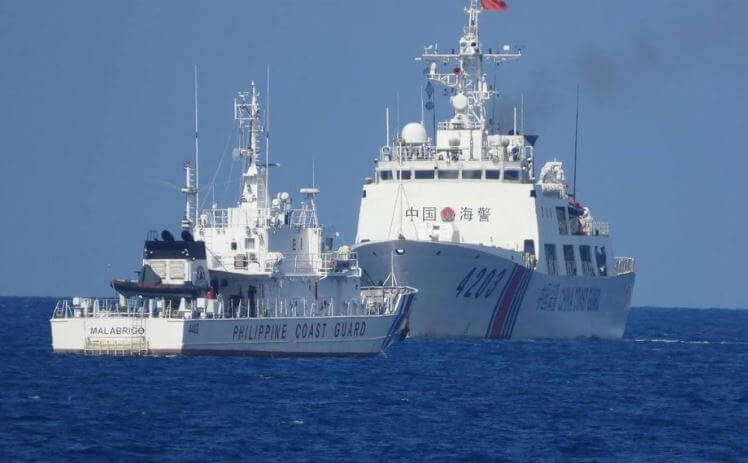Recently, the territorial dispute between the Philippines and China re-erupted, bringing the volatility of the South China Sea back into focus.
In October, a Chinese Coast Guard (CCG) ship and an accompanying vessel rammed into a Philippine coast guard ship and a military-run supply boat off the contested Second Thomas Shoal, where China has repeatedly tried to isolate a Philippine marine outpost.
Officials from Manila said that the face-off could have been “worse if the vessels were not able to manoeuvre rapidly away from the Chinese ships.”
Meanwhile, the Chinese Foreign Ministry reported in its own statement that two civil vessels and two coast guard vessels of the Philippines had “intruded the waters of Ren’ai Jiao in China’s Nansha Qundao… without China’s permission.”
Following this, the Philippines pulled out of China’s Belt and Road Initiative, but did not publicly confirm its reason for doing so.
Past Incidents
However, the latest incident is not unique. It follows a long string of disputes over the maritime body over the past decade, revealing the complex nature of China and the Philippines’ maritime disagreements.
A tense standoff unfolded in 2012, when Chinese vessels blockaded the shoal, preventing Filipino fishermen from accessing traditional fishing grounds. Despite international concern, China maintained control, sparking diplomatic tensions.
In 2018, reports emerged of Chinese vessels swarming the shoal, raising renewed concerns.
The situation escalated further in 2019, when a Chinese militia vessel collided with a Filipino fishing boat in the vicinity.
In the following year, despite the backdrop of the COVID-19 pandemic, Chinese vessels were spotted in the disputed waters, leading to renewed protests from the Philippines.
So, What is the Scarborough Shoal?
The Scarborough Shoal, also known as Huangyan Island in China and Panatag Shoal in the Philippines, is a disputed area in the South China Sea. The triangular-shaped chain of reefs and rocks is located approximately 120 nautical miles west of the Philippines’ Luzon Island.
Strategic Importance
The Scarborough Shoal has been a focal point in territorial disputes between the two because of its strategic importance in both military and economic terms, as it is positioned along key maritime routes.
The South China Sea is a major maritime route, and therefore, control over the Scarborough Shoal provides the controlling nation with influence over sea lanes, allowing for strategic positioning and monitoring of naval traffic.
The volatile sea is one of the world’s busiest shipping lanes, facilitating trade between East Asia and other parts of the world, the control of which impacts international trade and commerce.
In addition, the area holds economic importance due to its rich marine biodiversity, serving as a fishing ground for local communities. The abundant fisheries surrounding the shoal attract fishermen from various nations.
Moreover, it offers a vantage point for monitoring and potentially controlling air and naval activities in the surrounding area, providing a strategic advantage in military operations.
Chinese Defense Ministry urges Japan to stop building "small circles" and stirring up trouble in the South China Sea amid Japan's plan to provide the Philippines with radars in a move to "deter" China. pic.twitter.com/QTUcBgxmul
— Global Times (@globaltimesnews) November 16, 2023
Historical Disputes
Historically, the context of the Scarborough Shoal is marred by territorial disputes between China and the Philippines. China’s assertive claims over the South China Sea, including the Scarborough Shoal, have sparked international concern and protests from neighbouring countries, challenging freedom of navigation in the region.
Despite efforts to find a resolution through international arbitration, the dispute remains unresolved, highlighting the complex geopolitical landscape and the ongoing struggle for control over the region’s vital maritime resources.
International Claims and Ruling
China and the Philippines have long-standing and conflicting claims over the shoal.
China asserts historical sovereignty over the region, referencing ancient maps and documents to support its stance.
Meanwhile, the Philippines argues that the shoal is well within its exclusive economic zone (EEZ) based on the United Nations Convention on the Law of the Sea (UNCLOS), to which both nations are parties.
Tensions escalated in 2012, when a naval standoff occurred between the two nations, leading to China seizing control of the shoal and increasing diplomatic strain.
Following the 2012 incident, the Permanent Court of Arbitration in The Hague ruled in favour of the Philippines in 2016, declaring China’s historical claims invalid. It asserted that the shoal is a traditional fishing ground that should be accessible to all.
However, China rejected the ruling, highlighting its non-compliance with the decision. Despite diplomatic efforts to find a resolution, the Scarborough Shoal remains a flashpoint in bilateral relations, and enforcing international maritime law in the region remains challenging.
Nine Dash Line
China uses the controversial Nine-Dash Line to justify its vast regional claims and establish dominance in the South China Sea.
The demarcation encircles almost the entire South China Sea, which has escalated geopolitical tensions, as its expansive claim overlaps with maritime territories of neighbouring countries like Vietnam, the Philippines, and Malaysia.
The UNCLOS rejects Beijing’s broad claims, yet, this has not stopped the superpower from constructing artificial islands with military infrastructure in disputed waters.
Roadmap to Resolution
While there is no resolution to the dispute in sight in the near future, any effort towards the end goal would require sustained diplomatic engagement, joint commitment to peaceful solutions, and a willingness to compromise. Regional cooperation and international support will be key in securing a more stable future.
During a meeting with Chinese leader Xi Jinping in San Francisco this week, US President Joe Biden was expected to discuss the harassment of Filipino vessels near a disputed shoal in the South China Sea. However, the resolution of such a complex issue will require continued engagement at the highest level.

